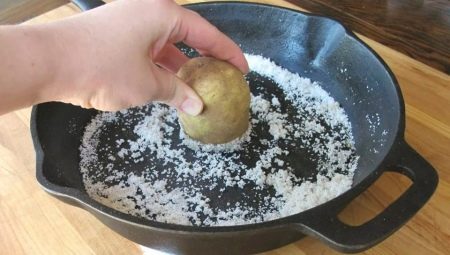Not everyone knows that before you start cooking most dishes, the pan should be calcined. And many do not attach much importance to this. Professional chefs will never miss this important process, but understanding this will require a deeper understanding of the matter.
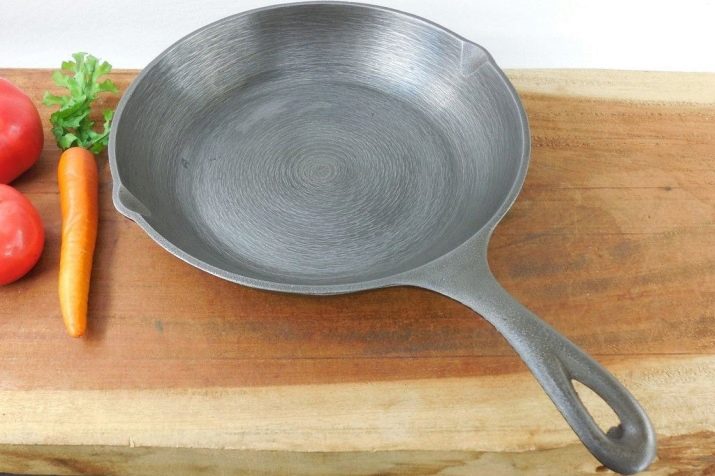
Why bake a pan?
No matter how much you would like, you can’t immediately put a new cast iron frying pan on the stove and start cooking in it. The calcination process has been used since the days of Ancient Russia, only then its main task was to create a natural non-stick coating. Today, there are many other reasons why it is necessary to process the metal efficiently before starting its operation.
Before you start calcining the pan, you will need to prepare for use, namely, first clean it. To speed up the process of removing traces of rust, a metal scraper or a hard sponge is ideal. After the dishes are well washed under running water with a dishwashing agent. Now you need to wipe the cast-iron skillet dry.
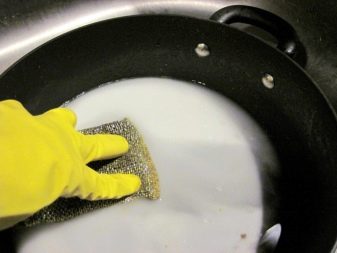
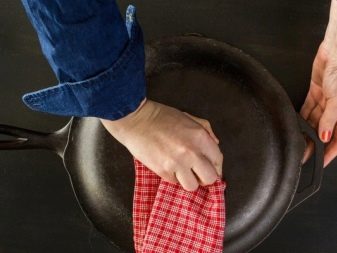
The calcination process is necessary for several reasons. With its help, it is possible to achieve certain results.
- Remove the grease that was applied at the factory in the manufacture of the product from the dishes. Everyone should know that it is harmful to humans, but you just cannot do without such lubrication, since its absence will not allow you to easily remove the pan from the press.
- Metal is often coated with sealant, which during storage protects against corrosion. Most products are designed to give the finished product an attractive shine.Any of them is harmful, can lead not only to the appearance of an allergic reaction, but also serious poisoning. You can understand that there is a harmful film on the dishes due to the pungent smell, as well as the poor taste of the prepared products. But it’s better not to experiment like this, as this can be harmful to your health.
- Annealing helps to find out if there is a manufacturing defect in the pan. If it is, then in the process of heating, small cracks and deformations will become visible. If the product is unsuitable for subsequent use, then it can be safely returned to the seller.
- Annealing helps to create a natural non-stick layer on the surface of cast iron cookware, which is extremely necessary in the manufacture of pancakes and pancakes. Despite the fact that cast iron is a metal, it has a porous structure, so food gets into its pores, which then starts to smell unpleasantly due to the fact that it burns. Calcination prevents this process.
- Over time, soot will accumulate in the pan, it is harmful to human health, so it must be removed. Calcination greatly simplifies the process.
- In addition, prolonged heating of the pan allows to increase the service life of the product, since then the likelihood of rust is significantly reduced.
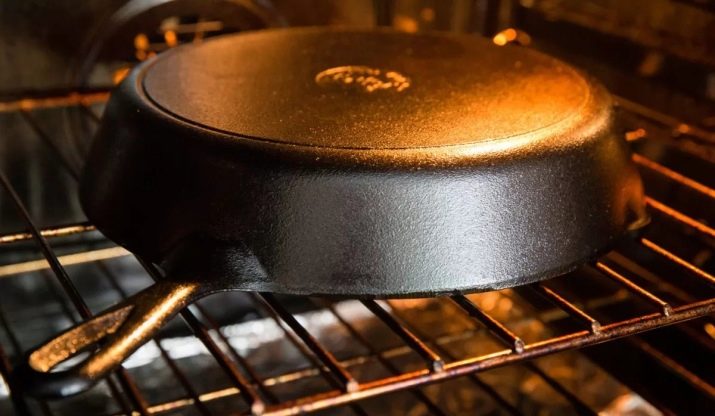
In the process of calcination with oil, two factors act on the metal: high temperature and oil, which when heated penetrates the expanded pores.
After the pan has cooled, its pores will close, but the oil will remain in them, which will create a protective layer. If the cast-iron frying pan is covered with an enamel layer, then there is no need to calcine it. Before first use after purchase, it is enough to wash such dishes with a cleaning agent.
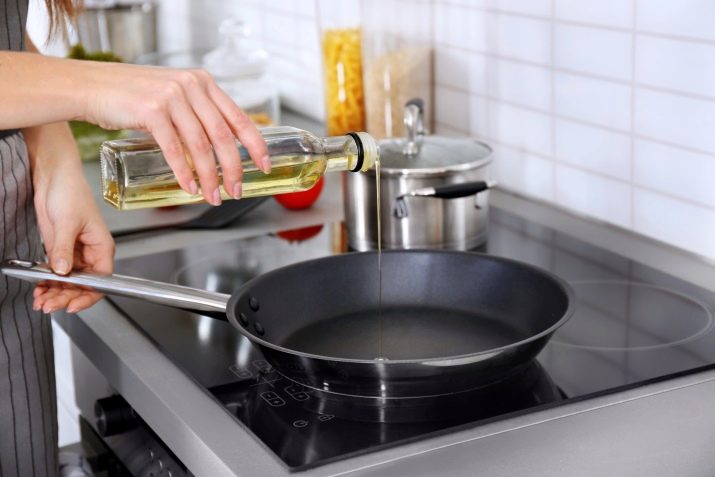
Ways
There are many ways you can prepare a cast-iron frying pan before first use. All of them are simple and affordable for every housewife.
Using ordinary table salt
In this case, you will need to take not iodized product, but coarse salt. Inside the pan, it is poured to the bottom so that it covers it with a thickness of one centimeter.
Turn on the burner on medium heat and set the dishes. Holding time from 10 to 20 minutes, this is enough. In each case, it is worth relying more on the size of the heated pan and the intensity of the flame.
The salt will need to be stirred occasionally.
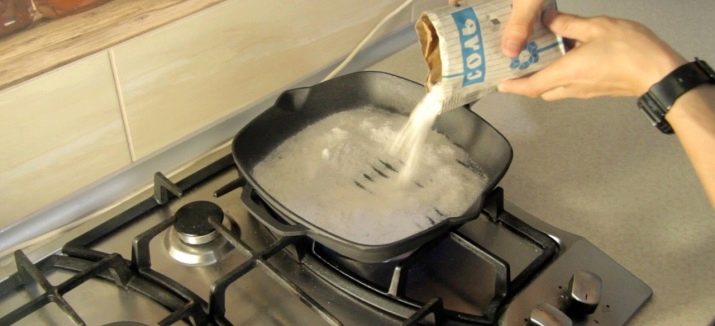
An unpleasant odor may appear, this is not surprising, so factory grease comes out of the pores of cast iron. White salt will soon change its color and turn yellow, closer even to brown, and sometimes black, which indicates a large amount of harmful substance on the surface.
The pan is removed from the heat and left to cool until the salt becomes cold. It can no longer be used as food, therefore they are thrown out without regret, and the dishes are washed under a tap with a cleaning agent, then they are wiped dry and rubbed with sunflower oil.
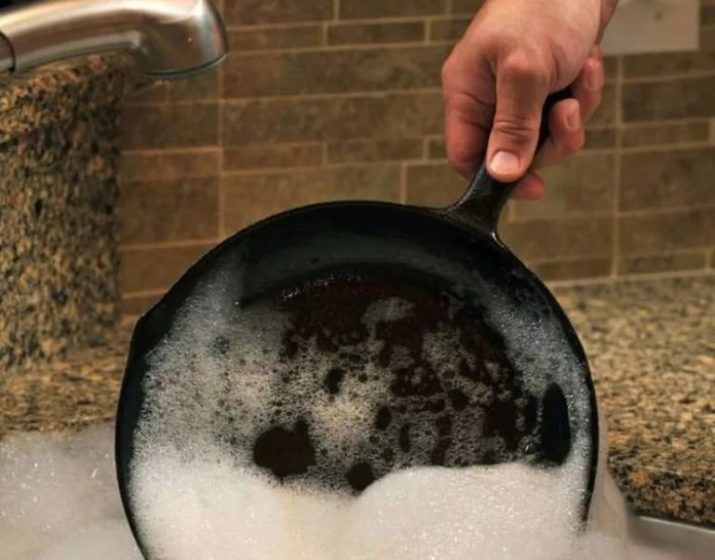
The calcination process did not end there. The pan is again set on fire and heated, but now the intensity of the flame should be minimal. In order for oil to get into the pores of cast iron, five minutes on fire is enough. If a gray color appears, then it indicates that the dishes are warmed up qualitatively. Now you can rinse again gently in cold water and rub with salt.
Before storing, wipe the pan well.
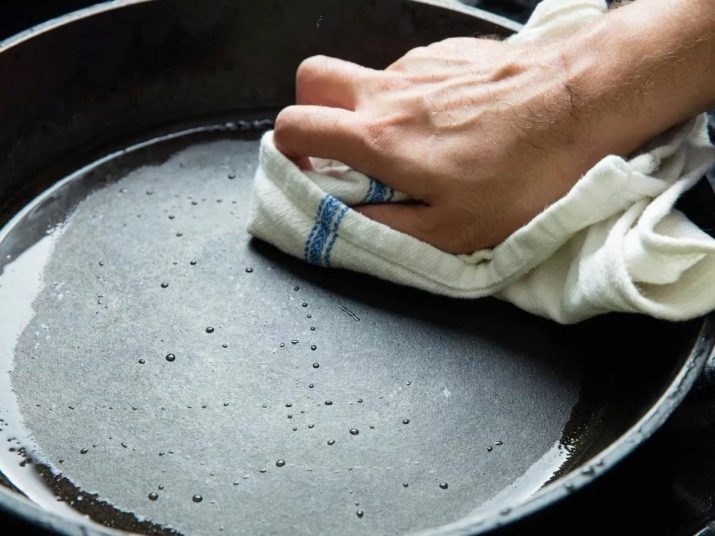
Using only oil
There are several ways to properly heat cast iron cookware at home using vegetable oil alone.
In the first case, you will need to put the container on fire and hold it there for five minutes. Only after the metal warms up well, gently pour a thin stream of oil. It should be so much that it completely covers the bottom of the pan.
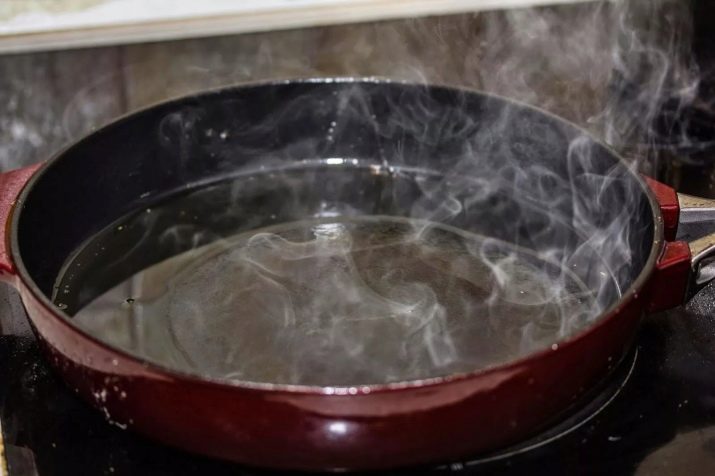
Some housewives do not know which product is best used for calcination. Experienced cooks agree that refined oil is ideal for this, since it does not emit as much smoke and burning as unrefined. Olive is expensive, so you can use inexpensive sunflower. It is allowed even to simply grease the surface with fat.
In the process of calcination, it will be necessary to ensure high-quality ventilation in the kitchen, for this they include a hood. If one is missing, then open the windows in the apartment.

Cast iron should stand on a small fire on the stove for thirty minutes. After they allow the dishes to cool, using a tack, take the handle and drain all excess oil. Now the pan is substituted under a stream of cold water and the whole process is repeated again. Three times is enough to properly heat the dishes.
For the last time, washing the oil under cold water, wipe the bottom and walls with a rag, but do not use a cleaning agent. Natural non-stick coating will protect the dishes during storage.
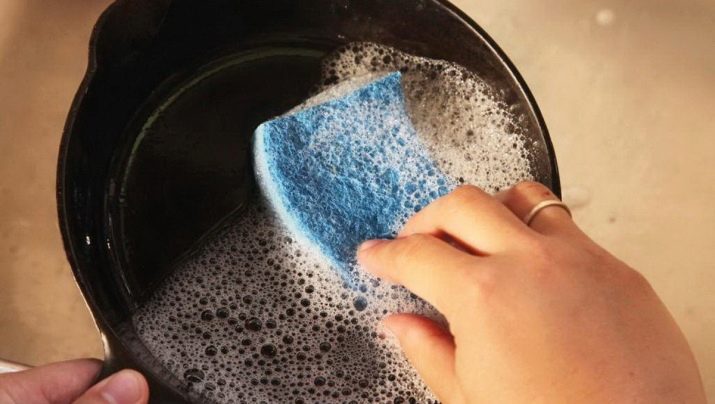
You can use the second method, but it will require a lot more oil, so it is likely that it can suddenly erupt. The pan should be monitored and not leave for a minute.
Before putting the dishes on the fire, oil is poured into the middle to the middle. The fire on the stove should be medium, the duration of the procedure is 30 minutes. After the pan becomes cold, the product is drained, the metal is wiped and removed for storage.
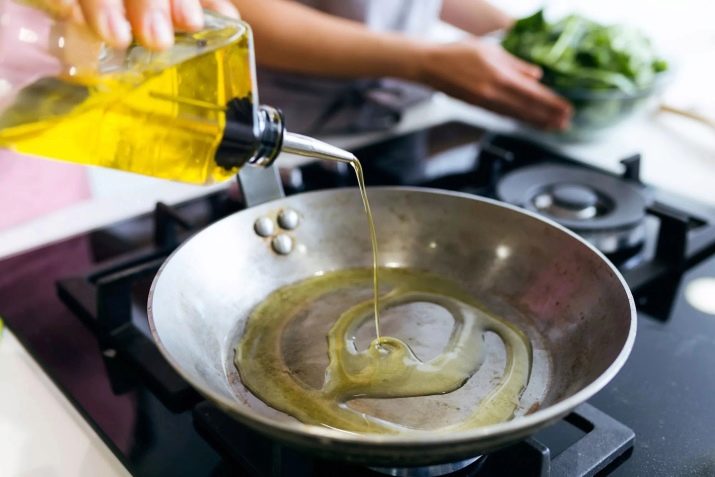
On the stove
It does not matter whether a gas or electric stove will be used, this method is very popular, although it consists of six stages. First you need to turn on the hotplate to the maximum. If this is an electric stove, then you need to warm it up well.
It is possible to determine whether the dishes have been calcined qualitatively by the appearing gray shade. At the second stage, they are taken with the help of a tack by the handle and dipped in cold water. A sharp change in temperature allows you to increase the strength of the product. Without wiping the pan, it is again sent to the fire, a small amount of salt is poured, which should absorb not only moisture, but also harmful grease.
When the dishes have completely cooled down, throw out the salt, grease the walls and the bottom with an oiled rag and again heat the cast iron on the stove for five minutes.
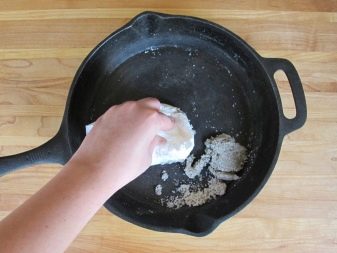
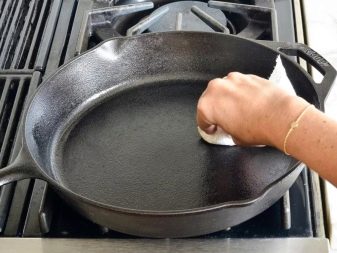
In the oven
The step-by-step process of using the oven looks very simple and affordable. With a more detailed study of the issue, any housewife can cope with the calcination of cast iron, even if before that she had no experience.
When using the oven, you will need to turn the container upside down. First you need to grease the product well with oil on all sides. If there is a wooden or plastic handle, then it will need to be removed. In the case when it is non-removable, they are not advised to touch it, but it is better to use any other method.
At the bottom of the oven, it is advisable to install a baking sheet on which oil can drip when heated.

The temperature inside should be at least 180 C. The pan is placed inside for an hour. Smoke may form in the process, so don’t be afraid, it’s better to open the windows or turn on the hood. After the specified time, the oven turns off, but the dishes remain inside until it cools.
If the procedure is repeated several times, then the natural non-stick layer becomes larger and better.
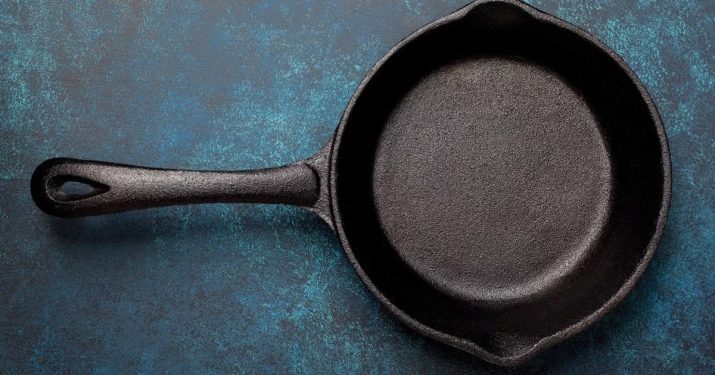
For deep dishes
It is inconvenient to calcinate ducklings, cauldrons and other cast-iron utensils by all the indicated methods. There is another way, although it takes more time, allows you to achieve the desired result. Burning in this way is not always convenient, but sometimes this is the only way to increase the life of the product.
From the hostess will need to grease the bottom and walls with oil, make a fire on the site and put the container directly into the fire. There should not be any wooden and plastic elements on it, and such a method is available only to those who have their own private home.
After some time, the surface of the pan or other dishes from cast iron will turn into gray, this suggests that the process can be completed.
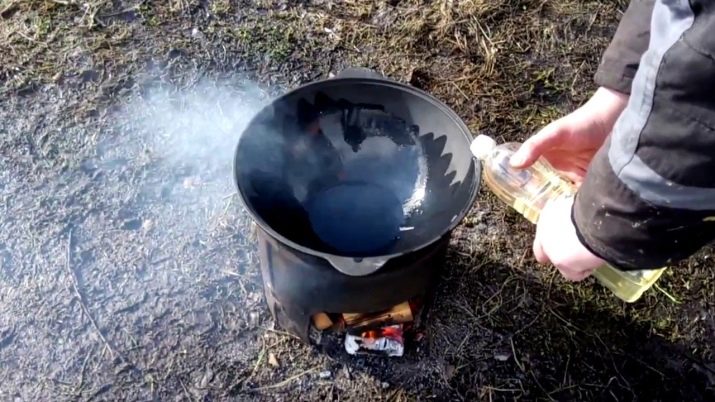
Follow-up care
Annealing provides longevity for cast iron containers, but they still require care if you want them to last a really long time. It is advised to wash such dishes immediately after the cooking process is over. Do this under cool water, since it is not necessary that the oil be washed out from then on.
Do not clean cast iron in the dishwasher, or store food inside.
After each use, it is worth lubricating the walls and bottom again with a small amount of vegetable oil.
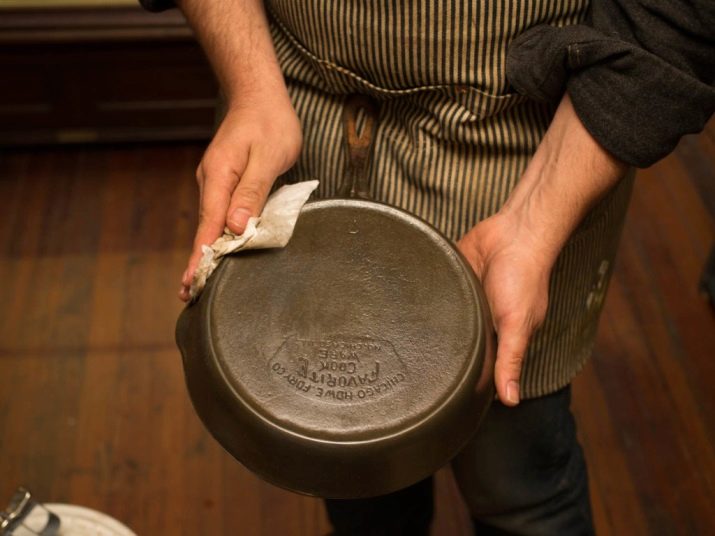
Do not use coarse brushes, abrasives, or metal scrapers during cleaning, as they remove the protective layer. If a cleaning agent is used, then after it the cast iron is again lubricated and calcined for half an hour. If you need to remove burnt food, then you need to boil a small amount of water in a pan with the addition of two tablespoons of salt and soda.
The storage location of cast iron utensils must be well ventilated, otherwise mold, an unpleasant odor will appear. It is stored with an open lid, absolutely dry. Even with infrequent use, it is advised to periodically lubricate the dishes with grease or oil.

Useful Tips
Some housewives have to deal with the process of calcining cast iron for the first time, others have repeatedly processed utensils, therefore, they give their advice on how to do this quickly and easily.
- It is best to do annealing of cast iron while no one is home. During the evaporation of the factory protective layer, a lot of smoke is generated, an unpleasant smell is in the apartment. To prevent the room from smelling, it is necessary to open the windows even before the calcination begins.
- Oil plays an important role in the process, so a refined product is the perfect solution. Olive is more suitable than vegetable, but it also costs more. You can replace with fat, including lamb, goose, interior or pork.
- If the hostess forgets to remove the fusible parts from the pan, the product will be irreparably damaged. It also happens that it is not possible to remove the handle, therefore it is possible to calcine such a pan exclusively on the stove, but it is strictly forbidden to use an open fire or an oven.
- Sometimes, before calcining, the cast iron is quenched. To do this, they put it on the burner, which works at maximum. When the surface color changes from black to gray, the metal is quickly dipped in cold water. If cracks and other deformations appear on the bottom or walls, this indicates that cast iron is of poor quality.
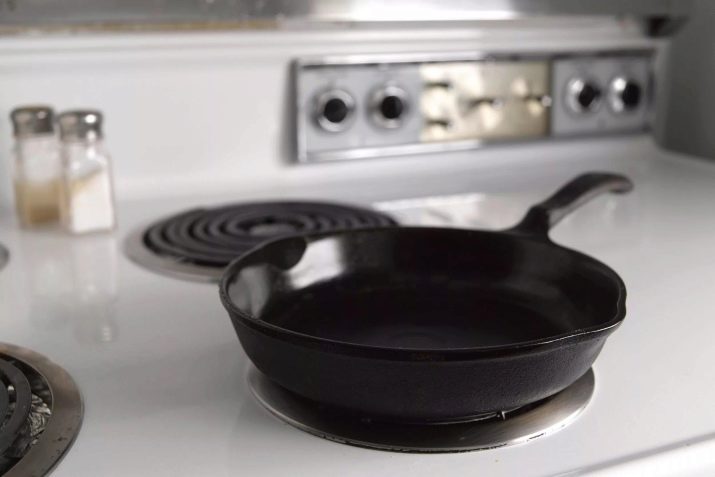
It is very important not to forget about safety measures. In no case do not touch the handle of the hot pan with your bare hands, but use a tack, towel or mittens. The product standing on the fire should be supervised, there are cases when the oil ignited. If safety precautions are not followed, the likelihood of a fire in the apartment increases.
In no case should there be a child in the kitchen, since cast iron is heated to a high temperature and any contact with it will cause a serious burn.
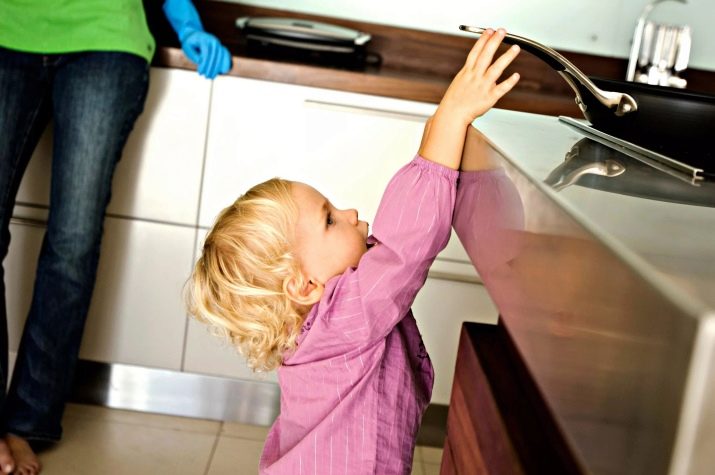
In conclusion, it is worth saying that cast-iron pans have a lot of advantages, especially when cooking a traditional Russian dish - pancakes. In such dishes, they turn out to be incredibly tasty, because they are well baked and do not burn, however, at the first use you can feel an unpleasant smell and even taste. In order not to spoil the food, any cast-iron frying pan must first be calcined and only then can it be cooked on it.
If everything is done correctly, the hostess will have an indispensable assistant for many years, with which you can cook delicious steaks, meatballs, fried fish and other delicious dishes.
See how to prepare a cast iron skillet for use in the video below.
